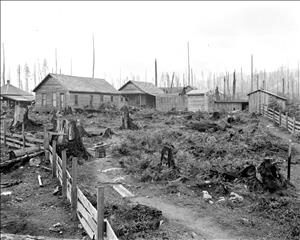Japanese immigrants began arriving in the Seattle area in the 1890s to work in the labor-intensive industries of railroad construction, logging, mining, fish processing, and agriculture. In Japan, the transformation of society and government from the feudal era to modern times, had taken a toll on the large peasant class. Farmers were saddled with new taxes and a fall in the price of rice. Thousands of farmers and peasants lost their homes and land. Immigration seemed an attractive option to many rural Japanese.
Japanese first immigrated to Hawaii in 1868. When the Chinese Exclusion Act of 1882 cut off the supply of Chinese workers, Japanese labor filled the void. Large-scale immigration to the mainland from both Hawaii and Japan began in the 1890s and continued until 1924.
A Golden Picture
In Japan, ship owners and emigration companies recruited workers through ads in daily newspapers and painted a golden picture of America as a land of "money trees" with "gold, silver and gems ... scattered on the streets." Impoverished, debt-ridden farmers were only too eager to believe. The Oriental Trading Company of Seattle was among several brokers that recruited labor for major railroad companies in the Northwest, signing up workers from branch offices in Hiroshima and Wakayama prefectures.
Early Arrivals
During the two-week voyage from Japan, hope often turned to despair. Passengers were squeezed into dark, damp holds of ships, enduring seasickness, lice-infested beds, poor ventilation, and nearly inedible food.
Seattle and Tacoma were the major ports of entry on Puget Sound. In Seattle, the steamships docked at Smith Cove at the north end of Elliott Bay. Early Japanese arrivals included students, young men seeking to avoid the military draft, unemployed veterans of the Russo-Japanese War, and second and third sons, who by Japanese law could not inherit land. Most of the Japanese immigrating to the Northwest came from rural regions in Hiroshima, Yamaguchi, and Okayama prefectures.
The 1908 Gentlemen's Agreement between the U.S. and Japan restricted immigration of laboring men, but allowed wives. Men frequently wed "picture brides" from their home villages in marriages that were arranged by their parents. After an exchange of photographs and family histories, the bride would come to the United States. Because the U.S. government didn't recognize the legality of such weddings until 1917, group marriage ceremonies were conducted in immigration offices. Japan cut off the flow of picture brides in 1920, under pressure from the United States.
The Immigration Act of 1924 virtually ended all immigration from Japan and Asia. The law wasn't reversed until 1965, when a new law lifted restrictions and allowed much broader immigration from Asia. Previous to that, in the 1950s, thousands of "war brides" -- Japanese women married to American military men -- arrived in the country.

